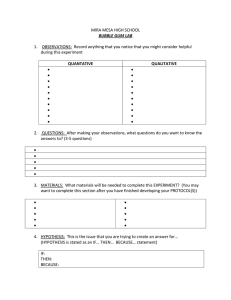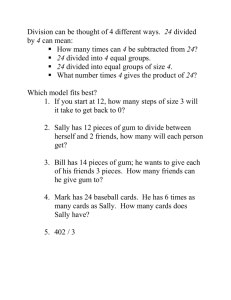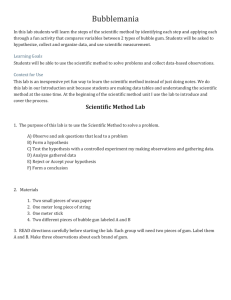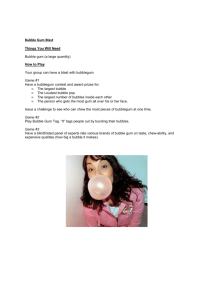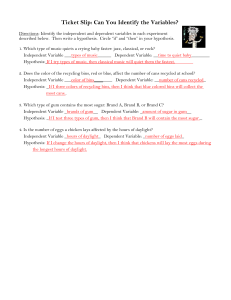Scientific Method
advertisement
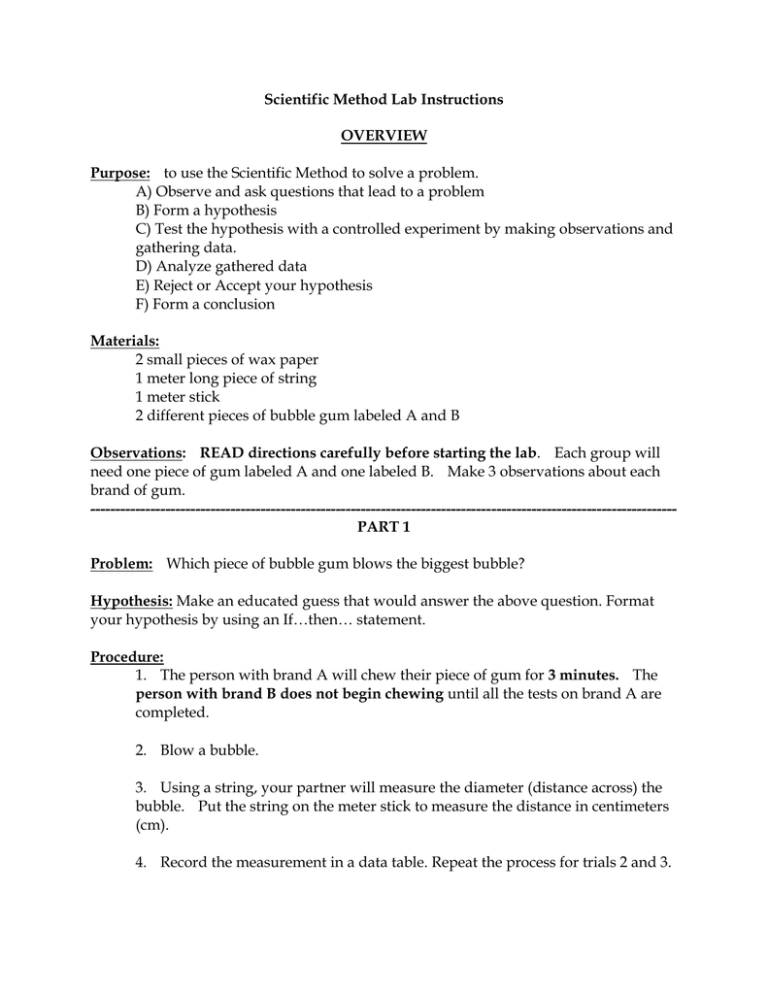
Scientific Method Lab Instructions OVERVIEW Purpose: to use the Scientific Method to solve a problem. A) Observe and ask questions that lead to a problem B) Form a hypothesis C) Test the hypothesis with a controlled experiment by making observations and gathering data. D) Analyze gathered data E) Reject or Accept your hypothesis F) Form a conclusion Materials: 2 small pieces of wax paper 1 meter long piece of string 1 meter stick 2 different pieces of bubble gum labeled A and B Observations: READ directions carefully before starting the lab. Each group will need one piece of gum labeled A and one labeled B. Make 3 observations about each brand of gum. --------------------------------------------------------------------------------------------------------------------PART 1 Problem: Which piece of bubble gum blows the biggest bubble? Hypothesis: Make an educated guess that would answer the above question. Format your hypothesis by using an If…then… statement. Procedure: 1. The person with brand A will chew their piece of gum for 3 minutes. The person with brand B does not begin chewing until all the tests on brand A are completed. 2. Blow a bubble. 3. Using a string, your partner will measure the diameter (distance across) the bubble. Put the string on the meter stick to measure the distance in centimeters (cm). 4. Record the measurement in a data table. Repeat the process for trials 2 and 3. 5. Find the average bubble size for brand A (add all the distances up and divide by 3) and put in the data chart. 6. Repeat steps 1-5 with brand B gum. Data Table: Design a data collection table to fit the data you will be investigating. --------------------------------------------------------------------------------------------------------------------PART 2 Combine with another group to complete this part of the lab. Problem: How does gum stretchability relate to bubble size? Hypothesis: Make an educated guess that would answer the above question. Procedure: 1. The person with brand A will roll their gum into a ball. 2. Hold the gum (brand A) by using the piece of wax paper. Another person in the group would hold the same piece of gum with another piece of wax paper. Hold the gum near your chest, begin to walk slowly backwards. 3. The third person in the group should hold the meter stick and measure the distance in centimeters the gum stretched before breaking. 4. Record the measurement in the data chart. ONLY DO ONE TRIAL 5. Repeat #1-4 for brand B gum. Data Table: Create a data table to fit the data you will be gathering. --------------------------------------------------------------------------------------------------------------------CRITICAL THINKING Analysis Questions: 1. With your lab partner, list 5 variables that may affect the outcome of parts 1 and 2 of this experiment. 2. Explain how the data you collected can be described as both qualitative and quantitative. 3. Why were 2 different types of gum used? 4. Were SI units used in this lab? Explain. Conclusion: Create a final paragraph (6-8 sentences) that summarize and conclude the entire lab. COMPARE DATA FROM BOTH GROUPS IN PART 1 AND PART 2 What brand of gum is the best at blowing bubbles and why? Support your answer with observations and your data. How does gum stretchability relate to bubble size? Use the following format as a guide when you type up your official lab report. Scientific Method Lab Report OVERVIEW: Purpose of Lab: Materials: Observations: Part A: Problem: Hypothesis: Procedure: Data Table: PART B: Problem: Hypothesis: Procedure: Data Table: CRITICAL THINKING: Analysis Questions: Conclusion: Name _______________________
